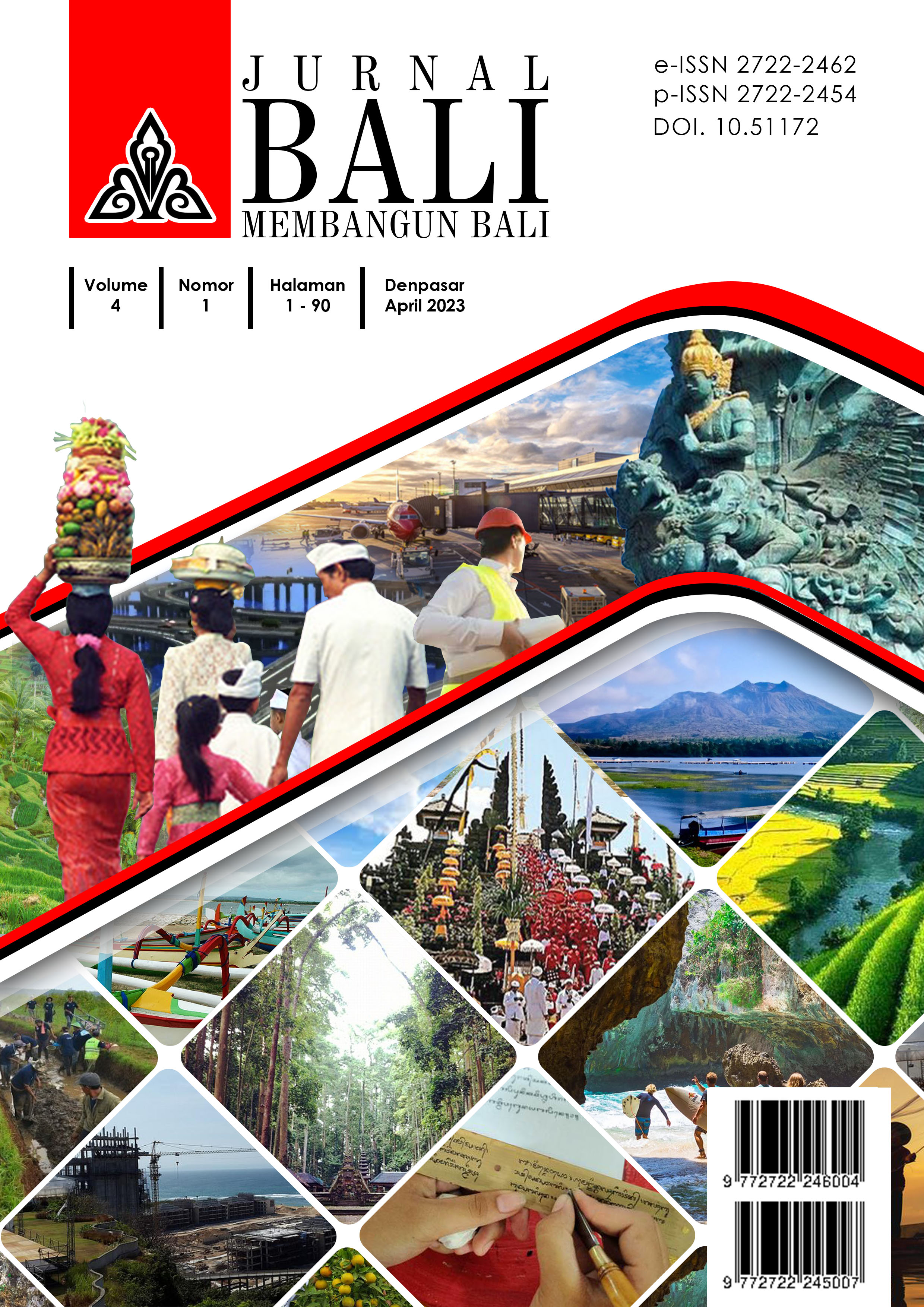Main Article Content
Abstract
Purpose: This research was conducted to analyze the communicative function of language and the meaning of kulkul in Balinese society.
Research methods: Data were collected using interview and observation methods with the help of note-taking techniques, then analyzed using descriptive-qualitative methods. This study uses the Cultural Linguistic Theory which is synergized with the Theory of Language Functions to analyze the function of kulkul and the Social Semiotics Theory to analyze the meaning of kulkul.
Results and discussion: Kulkul in Balinese society has a communicative function of language: informational, directive, aesthetic, and phatic. Based on this function, kulkul implies odalan (religious ceremony at the temple), kepancabhayan (crush), baya pati (rage), sangkepan/peparuman (meeting) or ngayah (mutual cooperation), and kelayusekaran (death of residents). Kulkul also has a sacred function, namely as a sign of a religious ceremony at the temple.
Implication: As a marker of Balinese culture (local wisdom), kulkul is a linguistic phenomenon, especially sign language which has a unique function and meaning.
Keywords
Article Details

This work is licensed under a Creative Commons Attribution-NonCommercial-ShareAlike 4.0 International License.
Authors who publish with this journal agree to the following terms:
Authors retain copyright and grant the journal right of first publication with the work simultaneously licensed under a Attribution-NonCommercial-ShareAlike 4.0 International (CC BY-NC-SA 4.0) that allows others to share the work with an acknowledgement of the work's authorship and initial publication in this journal.
Authors are able to enter into separate, additional contractual arrangements for the non-exclusive distribution of the journal's published version of the work (e.g., post it to an institutional repository or publish it in a book), with an acknowledgement of its initial publication in this journal.
Authors are permitted and encouraged to post their work online (e.g., in institutional repositories or on their website) prior to and during the submission process, as it can lead to productive exchanges, as well as earlier and greater citation of published work (See The Effect of Open Access).
References
- Chaedar, A. (1990). Pengantar Semantik Bahasa Indonesia. Rineka Cipta.
- Departemen Pendidikan Nasional Nasional. (2008). Kamus Besar Bahasa Indonesia: Pusat Bahasa.
- Djajasudarma, T. F. (2006). Metode Linguistik: Ancangan Metode Penelitian Dan Kajian.
- Frawley, W. (2013). Linguistic Semantics. Routledge.
- Halliday, M. A. K. (1992). Bahasa, Konteks, dan Teks: Aspek-aspek Bahasa dalam Pendangan Semiotik Sosial. Gadjah Mada University Press.
- Kridalaksana, H. (2008). Kamus Linguistik (IV). Jakarta: Gramedia.
- Leech, G. (1997). Semantik (Terjemahan Paina dan Soemitro).
- Mahsun, M. (2017). Metode Penelitian Bahasa. Tahapan, Strategi, Metode, dan Tekniknya. Rajawali Press.
- Mbete, A. M. (2004). “Linguistik Kebudayaan: Rintisan Konsep dan Beberapa Aspek Kajiannya. Dalam Bawa, I Wayan dan I Wayan Cika (Penyunting). Bahasa dalam Perspektif Kebudayaan. Denpasar: Universitas Udayana.
- Partami, N. L., Sudiana, I., Sukayana, I. N., & Purwiati, I. A. M. (2016). Kamus Bali-Indonesia: ed. 3.
- Pastika, I. W. (2005). Linguistik kebudayaan: konsep dan model. Jurnal Linguistika, 12(22), 102-112.
- Putra, I D. G. A. D. (2016). “Kulkul sebagai Media Komunikasi Tradisional dalam Desa Pakraman di Bali (Studi Kasus di Banjar Sari, Desa Pakraman Sukahet dan Banjar Pande Mas, Desa Adat Kuta). Dalam MEDIUM: Jurnal Ilmiah Mahasiswa Ilmu Komunikasi. https://ojs.unud.ac.id/index.php/komunikasi/article/view/20315.
- Refika Ayu Zellya, G., Arba Wirawan, I. K., & Darmawan, I. D. M. (2022). Artistic Arrangement as Semiotics of Criminal Messages in the Film “Marlina Si Pembunuh dalam Empat Babak”. Journal of Aesthetics, Creativity and Art Management, 1(1), 13–21. https://jurnal2.isi-dps.ac.id/index.php/jacam/article/view/1592; https://doi.org/10.31091/jacam.v1i1.1592.
- Riana, I. K. (2009). Linguistik budaya: kedudukan dan ranah pengkajiannya. Universitas Udayana Bidang Sastra & Budaya.
- Sadguna, I G. M. I. (2010). Kulkul Sebagai Simbol Budaya Masyarakat Bali. Artikel Bulan November, 11, 1-1.
- Santoso, R. (2003). Semiotika sosial: Pandangan terhadap bahasa. Pustaka Eureka dan JP Press.
- Sudaryanto. (1993). Metode dan aneka teknik analisis bahasa: Pengantar penelitian wahana kebudayaan secara linguistis. Duta Wacana University Press.
- Sutarma, I. G. P., & Sadia, I. K. (2017). Makna Bladbadan Bahasa Bali: Tinjauan Linguistik Kebudayaan. Soshum: Jurnal Sosial dan Humaniora, 5(3), 163.
- Sutarma, I. G. P., & Jendra, I. W. (2019, October). Pupuh Ginada “Eda Ngaden Awak Bisa”: Kajian Linguistik Kebudayaan. In Proceedings (pp. 77-86).
- Sutarma, I G. P. (2022). “Makna Paribasa Bali dalam “Geguritan Sampaik: I Sampik Tong Nawah Natah” (Tinjauan Linguistik Kebudayaan). Jurnal Bali Membangun Bali. Volume 3, Nomor 2, Agustus 2022. https://ejournal.baliprov.go.id/index.php/jbmb/article/view/231/160.
- Wadhanti, A. (2014). Efektifitas Pemanfaatan Kulkul Desa dalam Kegiatan Keagamaan Desa Adat Pengotan. Widyasrama, 23(1).

